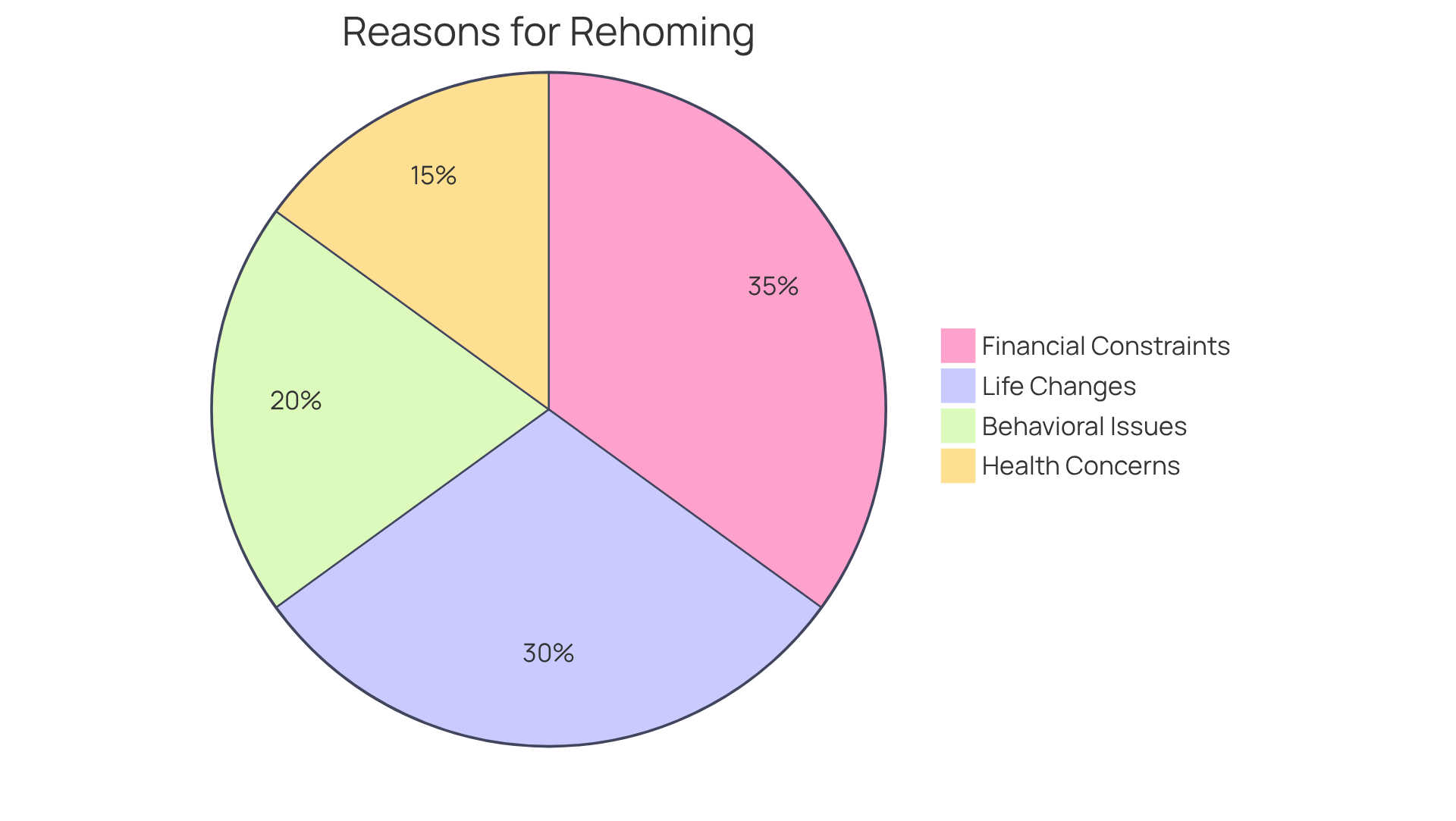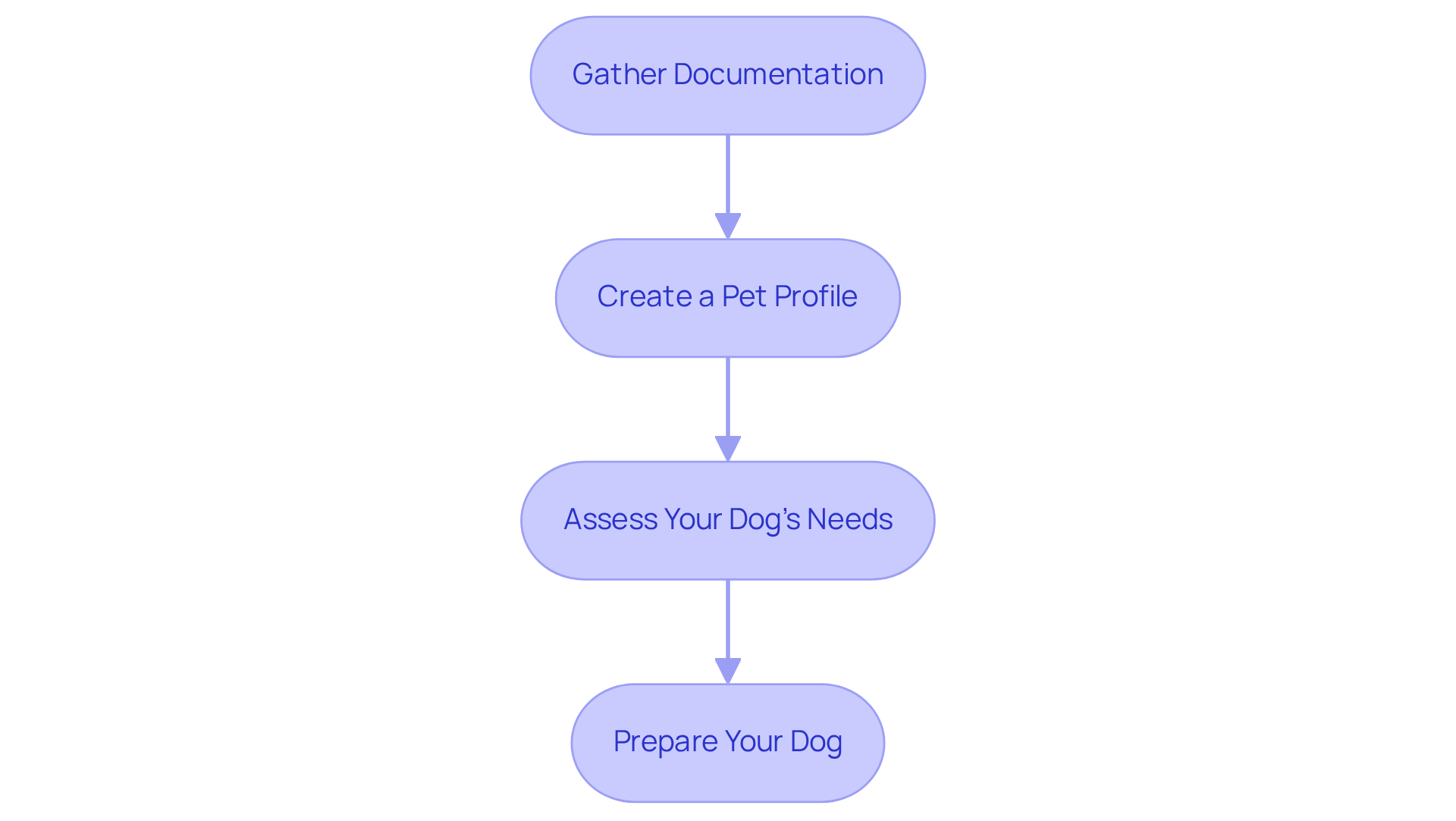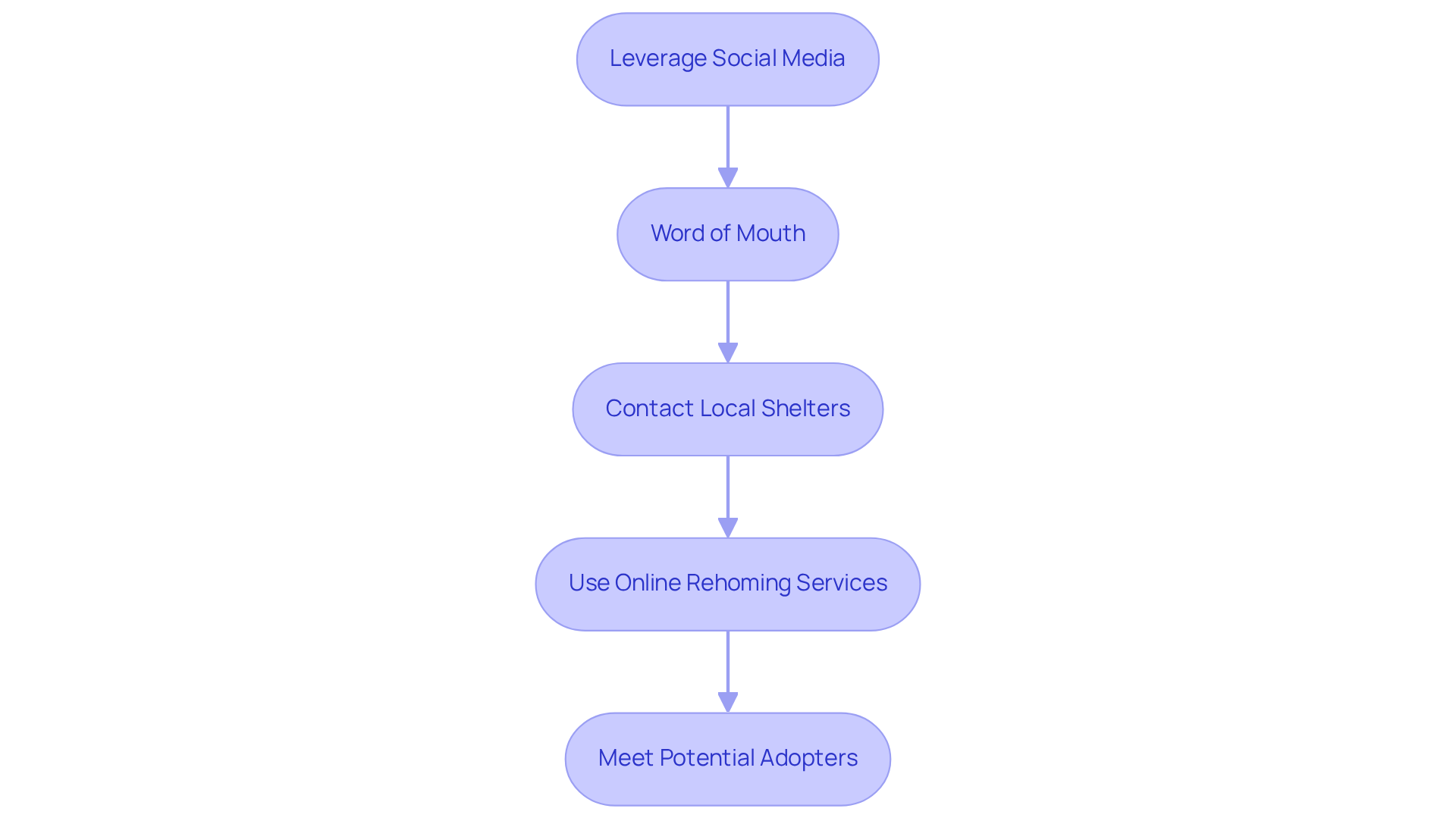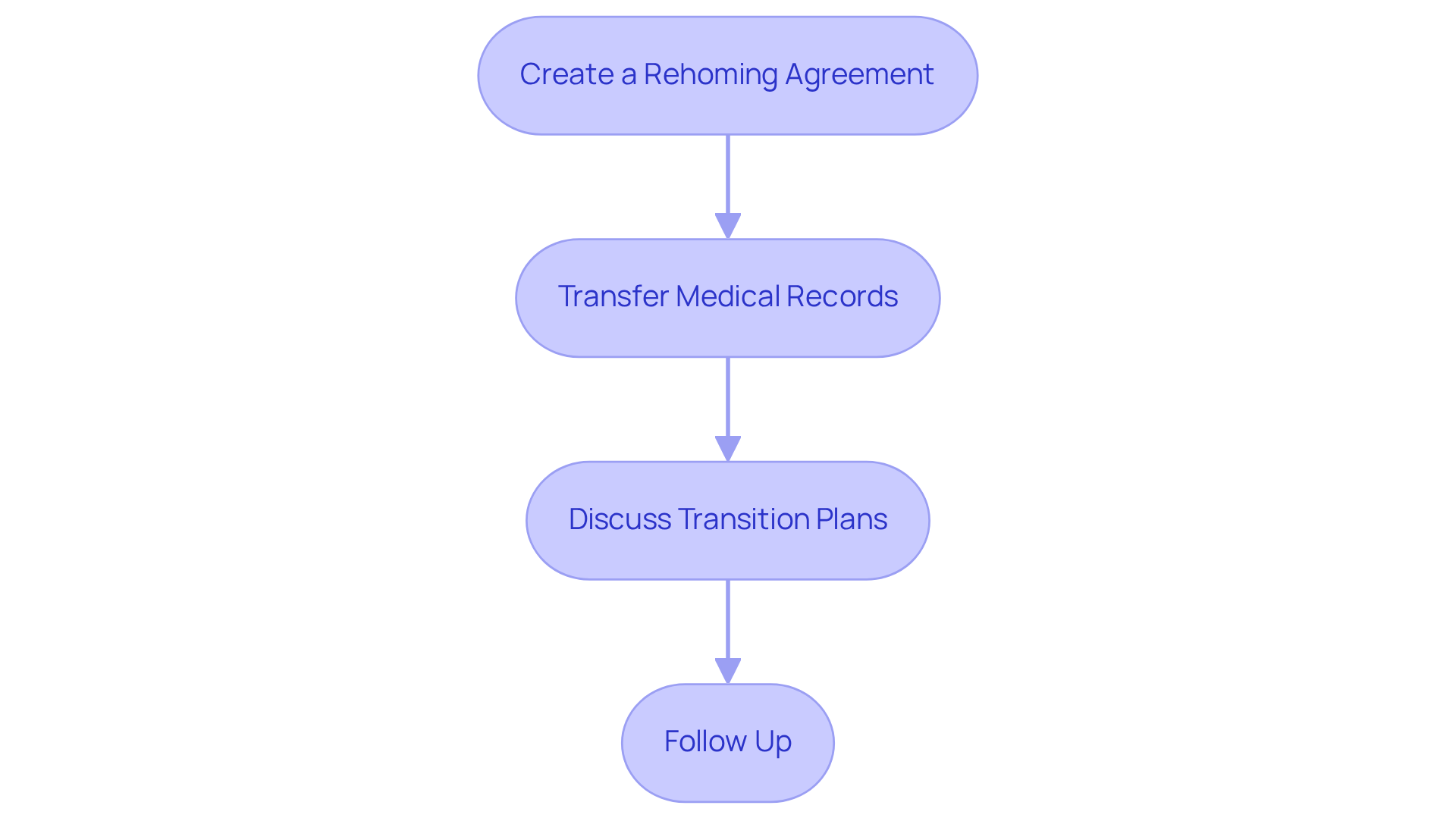
4 Steps for Successfully Rehoming a Dog with Ease
Overview
Successfully rehoming a dog can be an emotional journey, often filled with mixed feelings and concerns. It’s essential to understand the reasons behind the decision to rehome, prepare thoughtfully for the transition, find a loving and suitable new home, and finalize the process with care and compassion. This article outlines these important steps, emphasizing the significance of reflecting on your feelings and the well-being of your beloved pet.
By preparing thoroughly and communicating effectively with potential adopters, you can ensure a positive outcome for both your dog and the new owner, fostering a sense of hope and reassurance during this challenging time.
Introduction
Rehoming a dog can be one of the most heart-wrenching decisions a pet owner faces, often arising from unforeseen life changes, financial strains, or health concerns. Acknowledging these feelings is the first step in navigating this difficult journey. The emotional weight of such a decision is profound, as our pets are cherished members of our families.
This guide offers a compassionate roadmap through the emotional and logistical challenges of this process, ensuring that both the dog and the owner find a path forward that prioritizes well-being.
How can pet guardians navigate this difficult journey while ensuring their beloved companions find the right new home? It’s essential to explore not only the practical aspects but also the emotional ramifications of rehoming. By understanding the importance of quality pet care and the deep bond shared, we can approach this transition with empathy and care.
Understand the Need for Rehoming Your Dog
The process of rehoming a dog is a deeply emotional decision that calls for thoughtful reflection. It’s important to start by considering the reasons that may be leading you to this choice. Common factors include:
- Life Changes: Changes in your living situation, such as moving to a place that doesn’t allow pets or shifts within family dynamics, can make rehoming necessary.
- Financial Constraints: Many pet caregivers face financial difficulties that limit their ability to provide adequate care. Research shows that a considerable number of pet owners struggle with the costs associated with pet ownership, including food, veterinary care, and grooming.
- Behavioral Issues: Behavioral issues can create stress for both the pet and the caregiver, leading some to consider rehoming a dog as a potential solution.
- Health Concerns: Health concerns may impede a caregiver’s ability to care for their dog, which could lead to the need for rehoming a dog to ensure a better situation for their furry friend.
Reflecting on these factors is essential to determine if rehoming a dog is truly the best option for both you and your beloved dog. It may be beneficial to speak with a veterinarian or a pet behaviorist to explore alternative solutions before making a final decision. This step can offer valuable perspectives and support, ensuring that the choice made is in the best interest of your cherished companion.

Prepare for the Rehoming Process
When the decision of rehoming a dog arises, it’s essential to prepare thoughtfully. This transition can be challenging, but with proper steps, you can ensure a smooth experience for both you and your furry friend when considering rehoming a dog. Here are four vital steps to consider:
-
Gather Documentation: Begin by compiling your dog’s medical records, vaccination history, and any training certificates. This documentation is not just paperwork; it’s a lifeline for the new caretaker, providing them with a comprehensive understanding of your dog’s health and care needs.
-
Create a Pet Profile: Take the time to develop a detailed profile that highlights your dog’s personality traits, preferences, health issues, and any special care requirements. A well-crafted pet profile significantly increases the chances of finding a suitable adopter, as it helps prospective caregivers appreciate your dog’s unique needs and characteristics.
-
Assess Your Dog’s Needs: Reflect on the ideal home environment for your dog. Does your dog thrive in a lively household, or do they prefer a quieter, more serene setting? Understanding these needs will guide you in matching your dog with the right family, ultimately enhancing their chances for a successful transition.
-
Prepare Your Dog: Start acclimating your dog to new environments and people gradually. This gentle preparation can help ease anxiety during the relocation process, making the transition smoother for both your dog and the new owner.
By following these compassionate steps for rehoming a dog, you can create a positive relocation experience that prioritizes your dog’s well-being, thus increasing the likelihood of a successful match. Remember, you’re not alone in this journey; there are supportive communities and resources available to help you through this process.

Find a Suitable Home for Your Dog
Finding a suitable home for your beloved dog can be a heartfelt journey, particularly when it involves rehoming a dog, a situation many pet guardians face with a mix of hope and concern. It’s important to acknowledge the emotions tied to the process of rehoming a dog and recognize that there are several effective channels to explore.
-
Social Media: Consider leveraging platforms like Facebook and Instagram, along with local community groups, to share your dog’s profile. Joining dedicated pet adoption groups can significantly enhance visibility. Research shows that social media plays a crucial role in pet adoptions, with 75% of animal shelters noting its importance in achieving their goals. For instance, sharing the touching story of Daisy, a 9-year-old energetic girl who loves to play and is seeking a compassionate family, can resonate with potential adopters who connect with her journey.
-
Word of Mouth: Don’t hesitate to inform friends, family, and coworkers about your situation. Personal connections can lead to potential adopters, as they might know someone looking to welcome a dog into their home. This grassroots approach often yields successful outcomes, as trust and familiarity can facilitate the adoption process. Sharing heartwarming stories like that of Tasha, a 12-year-old dog who adores human attention and cuddles, can evoke empathy and encourage others to help find her a loving home.
-
Local Shelters and Rescue Groups: It’s also beneficial to reach out to nearby animal shelters or rescue organizations. These entities often have established networks and resources to assist in the process of rehoming a dog and finding homes for pets. Statistics reveal that 54% of felines and 46% of canines are adopted from shelters, underscoring the success of rehoming a dog initiatives. At Jet Pet Resort, canines like Max, a 9-month-old eager learner, and Bunny, a sweet girl who has overcome challenges, are waiting for their forever homes, showcasing the variety of personalities available for adoption.
-
Online rehoming services like PetRehomer and Adopt-a-Pet are useful for rehoming a dog, as they connect pet guardians with potential adopters. Providing comprehensive information about your dog, including personality traits and care needs, can attract the right match. Highlighting the heartwarming tales of canines at Jet Pet Resort, such as Daisy’s journey from being surrendered after an accident to seeking a new family, can make a compelling case for adoption.
-
Meet Potential Adopters: Once you have interested parties, arrange meetings to observe how they interact with your dog. This step is vital for ensuring compatibility and comfort for both the dog and the new owner. Engaging with potential adopters in a relaxed environment can help gauge their suitability as a new pet parent, ensuring that dogs like Daisy, Tasha, Max, and Bunny find the loving homes they truly deserve.

Finalize the Rehoming Process
Once you’ve found a loving home for your dog, like a caring family for affectionate companions such as Chico and Diesel, it’s time to embrace the rehoming process with compassion:
- Create a Rehoming Agreement: Draft a simple agreement that outlines the responsibilities of both parties. This can include care instructions, contact information, and any fees involved, ensuring clarity and understanding.
- Transfer Medical Records: Provide the new guardian with all medical records and vaccination history. This ensures they have all the necessary information for future veterinary care, fostering peace of mind for both you and the new owner.
- Discuss Transition Plans: Engage in a heartfelt conversation with the new guardian about how to smoothly transition your dog into their new home. Sharing tips on routines, feeding, and any behavioral quirks can make a world of difference during this adjustment period.
- Follow Up: After the relocation, take a moment to check in with the new owner to see how your dog is adjusting. This simple act can provide you with peace of mind and help you feel connected to your pet’s new life.
By following these thoughtful steps, you can ensure a smooth and compassionate process for rehoming a dog, giving them the chance to thrive in a new environment filled with love and playtime.

Conclusion
Rehoming a dog can indeed be a heart-wrenching yet necessary decision, often prompted by life changes, financial constraints, behavioral issues, or health concerns. Acknowledging the emotional weight of this choice is crucial, as it ensures that the decision made is in the best interest of both the pet and the caregiver. By approaching this process thoughtfully and compassionately, it becomes possible to navigate this transition with care and consideration.
This article outlines four essential steps to facilitate a successful rehoming experience. These steps include:
- Understanding the need for rehoming
- Preparing for the process
- Finding a suitable home
- Finalizing the rehoming
Each step plays a vital role in ensuring that the dog is matched with a loving family that meets their unique needs. From gathering documentation and creating a pet profile to engaging with potential adopters and discussing transition plans, these actions help foster a smooth transition for all parties involved.
Ultimately, rehoming a dog is not solely about finding a new home; it is about ensuring that the beloved pet continues to thrive in an environment that suits them. This journey requires empathy, diligence, and a steadfast commitment to the well-being of the dog. By following the outlined steps and utilizing available resources, caregivers can make informed choices that honor the bond they share with their furry companions, paving the way for a hopeful new beginning.
